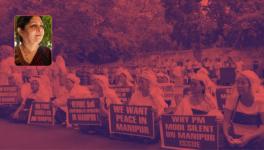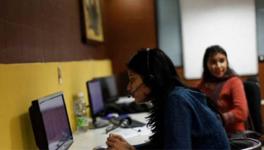Understanding Women’s Lives in Rajasthan

Image for representational purpose. Credit: The Hindu
The campaign for the just-concluded Assembly election in Rajasthan provided us with an opportunity to examine the lives of nearly half of its voters. Here, in five charts, we try to decode the life of women in Rajasthan and answer whether the statistics are in sync with the situation in other states and at the all India-level.
There are 2.51 crore women voters in Rajasthan out of the 5.25 crore total voters, according to the latest electoral data.
Women’s issues are among the ubiquitous election issues in all states, including Rajasthan, and political parties leave no stone unturned to woo this group of voters. While the Congress party has introduced many women-centric schemes in the state, it did not miss mentioning them in rallies and campaigns either. The BJP also did not leave any chance to attack the ruling government over increased atrocities on women in the state.
In September, Parliament took the significant step of passing the ‘Women’s Reservation Bill during a special session. The anticipation was that political parties would move beyond mere rhetoric to actively field women in Assembly elections, but this was not to be.
The two major players in Rajasthan politics are the Bharatiya Janata Party (BJP) and ruling Congress. However, neither party fielded a significant number of women in the poll held on 25 November.
Only 20 women, making up 10% of the total contestants, were in the fray from the BJP and 28, or 14% of total contestants, were given tickets by the Congress party.
Even this low number, however, marks an increase of 179% in the number of women contesting the Assembly election in Rajasthan between 1998 and 2018. The number of women reaching the Assembly after being elected has also witnessed an elevation—but of just 71%. This difference in growth percentages—179% and 71% implies that while the number of contestants is increasing, their share in power is not keeping pace with that growth. In fact, the share of women elected compared with the number of women who have been contesting elections has decreased—from 20.3% in 1998 to 12.69% in 2018. It means the election commission, public institutions, political parties and leaders need to do a lot more to encourage the acceptance for women leaders in politics.

Women constitute 47.80% of the total voters in Rajasthan. Although their share in polling has experienced a commendable increase of 15.79 percentage points between 1998 and 2018, there was a marginal contraction of 0.77 percentage points between the shorter sub-period of 2013 and 2018. Nevertheless, the female polling percentage in both 2013 and 2018 remained higher than that of males. This is an extremely important point to note—what it means is that more women are engaged in the voting process as a percentage than men in the state, which could be for a variety of factors.

Rajasthan remained among the bottom-performing states on the majority of women empowerment indicators. Only in 13.6% of the households in Rajasthan have women attained an education of 12 or more years. In 36.5% of households, women have received no schooling at all.
Further, 24.5% of women aged between 18-29 years in Rajasthan were married by the time they reached adulthood at 18 years of age. This is slightly better than the national share of 24.7%. Although Rajasthan is infamous for early marriages, the state actually ranks at the ninth place from the bottom on this metric. It is West Bengal which has the highest share of females getting married before the legal age of 18 years at 42.30. Further, 3.7% of girls aged 15-19 years have started childbearing in Rajasthan—this figure is almost four percentage points better than the national share of 6.8%.
Only 65.8% of women in Rajasthan participate in all three specific kinds of decision-making which are usually taken by women. These three decisions relate to their healthcare, making major household purchases, and paying visits to their family members or relatives. Rajasthan is the fourth worst-performing on this measure.
The National Family Health Survey recently revealed that educated women and women from wealthy backgrounds are more likely to use hygienic methods of menstrual protection. Some 90% of educated women used hygienic methods while only 44% of women with no schooling did so. The correspondent share for women with wealthy backgrounds and others is 95% and 54%, indicating a very wide gap.
However, Rajasthan fares better than other so-called BIMARU or least well-off and developed states, which include Bihar, Madhya Pradesh and Uttar Pradesh on this metric. Further, it is also better off than at the national level in terms of women using hygienic methods for menstrual protection. Around 84.3% of women in Rajasthan have access to hygienic methods on menstrual days, which the corresponding figures for India, Bihar, Madhya Pradesh, and Uttar Pradesh remained at 77.6%, 59.2%, 60.9%, and 72.9% respectively.

Women’s participation in the labour force (usual status, age group of 15 years and above) in Rajasthan is 10.9 percentage points higher than the national rate of 37%. However, the majority of women are self-employed with only 6.6% in regular salary or wage jobs and 10.8% in casual labour. Taken at face value for the present purposes, this data from the Periodic Labour Force Survey or PLFS is noteworthy for another reason: It indicates that the female labour force participation rate in Rajasthan remained higher than the national level in the five years between 2018-19 and 2022-23.

Accordingly, over the last five years, the female unemployment rate according to the usual status for the age group of 15 years and above in Rajasthan has contracted by 2.2 percentage points from 5.1% in 2018-19 to 2.9 in 2022-23. Unemployment in both rural and urban women of Rajasthan has decreased from 2% in 2018-19 to 1.7% in 2022-23 among rural women and from 14.2% in 2018-19 to 11.3% in 2022-23 among urban women. This data would indicate that Rajasthan is among the top performing states in terms of female unemployment.

The bad news for women in Rajasthan comes from the National Crime Records Bureau reports, which show that Rajasthan ranked second after Uttar Pradesh in overall crimes against women in 2021. Rajasthan also reported the highest number of rape cases in the country at 6,337. This marked an annual increase of 19.34%, as 5,310 cases were reported in 2020.
Although Rajasthan has improved on many indicators, such as the labour force participation rate and unemployment rate among women, the state has remained among the least performing states on the majority of women empowerment indicators.
(Sources for the data in this report include various studies of the National Family Health Survey, Periodic Labour Force Survey, Election Commission of India and the NCRB.)
The author is an independent journalist. The views are personal.
Get the latest reports & analysis with people's perspective on Protests, movements & deep analytical videos, discussions of the current affairs in your Telegram app. Subscribe to NewsClick's Telegram channel & get Real-Time updates on stories, as they get published on our website.
























